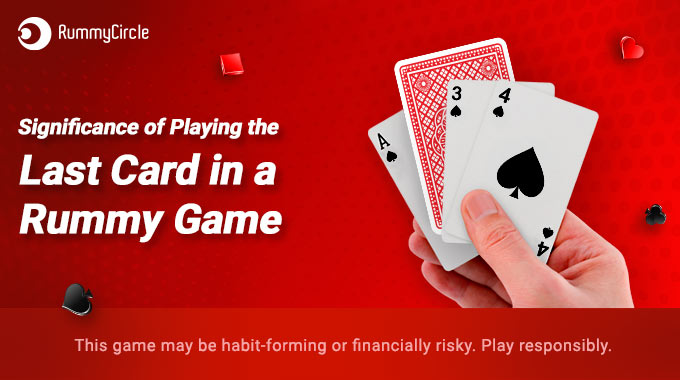Significance Of Playing The Last Card In Rummy
Rummy is a popular card game in India. There are very few possibilities that you have not indulged in the game at some social event, gathering or such. It has retained its popularity in its digital avatar amongst the people, and millions log in for some fun, entertainment and relaxation with a game of Rummy online.
Indian Rummy, also known as the 13-card Rummy, is played between 2 and 6 players.
Sequences and Sets
Rummy is all about forming sequences and sets and doing it fast. The game has rules and regulations regarding the same, and the bottom most player is penalized with points based on the cards in hand that are not part of a set or sequence.
We have covered many articles and blogs about the basic rules of the rummy game for the people interested in getting a head start at the game.
You can declare the game once you’ve complied with all the requirements for the right sequences and sets. indicating placing a card face down on the discard pile and displaying the 13 cards in the necessary sequences and sets. A pure set of three cards and a pure sequence of at least four cards, both without a joker, are necessary. You must create at least two sequences, one of which must be a pure sequence in order to win the game; the other sequences can be any legitimate sequence or set. You cannot make a legal declaration for a rummy game without a pure sequence. One of the key rummy principles is this.
Declaration
Your declarations will be considered invalid if there is no pure sequence of at least 4 cards.
A set with two face value cards of the same set. For example, a 5 of diamonds, a 5 of spade, and two 5s of hearts.
Declaring without two sequences. (For example, a pure sequence and then a second sequence can be with a joker.)
The remaining cards are arranged in sequences or sets.
Once you have covered the basic requirements of sequence and sets for playing the different variations of Rummy, you need to decide which card to use as a declaration. This means always keeping in mind that an extra card beyond the melding needs is to be kept aside.
Here are some tips to help you play the final card in Indian Rummy:
- The most obvious choice would be to set aside a duplicate card.
- The pure sequence should be formed at the very beginning of the game. Without a pure sequence, one cannot make a valid declaration.
- Focus on what your opponent discards and picks. Try to keep a card of that set or sequence aside to be used as a declaration card.
- Make longer sequences so that you can use a card from the sequence to declare if you have nothing set aside.
- Do not be very possessive of your joker or wild cards; they can also be used as the last card if you find them redundant.
- When you are set to make a declaration, you must check and recheck your cards before pressing the button. An invalid declaration can even turn around a winning game.
Rummy is a game of strategy and expertise, and developed skill. A skilled player can turn a bad set of cards in hand into a winning one with strategy and skill. Expertise is required for arranging the cards in a group. Proper decisions need to be made to decide what to discard and what to keep. It is advisable to play certain practice games before competing or playing against skilled opponents.




